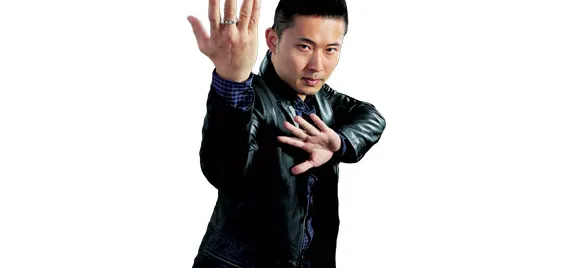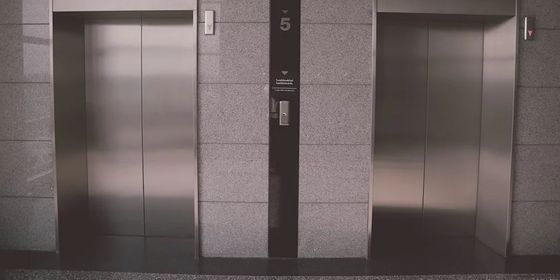An interview with kung fu master Zhao Jilong, founder of Fun Kungfu
PIONEER PROFILE
Zhao Jilong
Profession: Kung Fu Master
Nationality: Chinese
When it comes to martial arts, Zhao Jilong, is the man. Starting martial arts at the tender age of five, Zhao set out to master several styles, including Mizong Quan (迷踪拳, Lost Track Fist), Shaolin Quan (少林拳, Shaolin Fist Fighting), Xingyi Quan (形意拳, Fist of Intent), and Chuojiao Fanzi (戳脚翻子, literally, Feet Poking) to name just a few. In 2005, Zhao decided to start teaching kung fu abroad, opening the Kylin Martial Art School in Sydney. At the same time, he was busy perfecting other fighting skills, such as Thai Boxing and the fierce Israeli fighting system, Krav Maga. In 2012 he returned to China, becoming the executive consultant and host of the documentary series, Experiencing Real Kung Fu (《体验真功夫》Tǐyàn Zhēn Gōngfu) on CCTV-4. Researching the origins of various kung fu styles, he sought out a range of kung fu masters. Using his knowledge of different martial arts styles, he gradually developed his own style, Fun Kungfu, which aims to promote a mix of combat styles, kung fu, healthy living, and a practical training system. He also serves as the Deputy Chairman of the Committee of Chinese Kung Fu Championships (中国功夫争霸赛 Zhōngguó Gōngfu Zhēngbàsài).
How is your style of kung fu different?
First, it combines traditional and modern elements. This ensures it is based on sound science, but, at the same time, maintains the essence of the traditional elements. Second, it is an incredibly pared-down style; its beauty lies in its simplicity. Third, it’s very practical. By avoiding unnecessary complexity, my brand is straightforward to learn and simple to execute. All these features have come through my personal kung fu learning experience in both theory and practice. I studied IT at the University of Technology in Sydney, which trained me to be logical, rational, and analytical. I realized that Chinese kung fu lacked quantitative concepts. The language in training books, for example, is vague: 两脚分开,与肩同宽 (liǎng jiǎo fēnkāi, yǔ jiān tóng kuān, stand with two feet apart, to keep the width the same as your shoulders). Different widths for different learners will have different effects. When confronted with these questions, Chinese traditional kung fu masters had to correct learners’ actions one-by-one, depending on their students interpretation. Through observation and experiments, I was able to summarize and create an accurate expression explaining what was originally meant, which is that the acupuncture points of yongquan (涌泉) in the feet must be kept vertical to the jianjing (肩井穴) in your shoulder. Doing this will create a precise position for each student, which is the most effective standard for practice.
You are a martial arts master who is obviously good at combat. Have you tested your theory?
In 2001, when I arrived in Australia, Chinese kung fu was not mainstream. Japanese Karate and Republic of Korea’s Taekwondo were very popular. When they heard that I practiced Chinese kung fu, of course, they challenged me to many competitions. I accepted more than 30 times and, each time, I won under the agreed upon rules. In Chinese we call these kinds of competitions 切磋 (qiēcuō), which means learning by discussion and exchanging views. Being an expert in martial arts does mean you get some bizarre challenges. When I worked in the goods and materials supply business in South Sudan, a guy from a powerful Kenyan family, Tinta Akasha, was one of my main competitors. His company monopolized most of the business in the field, and he was not too pleased I was working on his patch. On hearing I practiced kung fu, he challenged me to combat. He thought kung fu was just dancing around with a fillet knife or something. Bear in mind that Tinta’s father is one of the biggest drug dealers in world [unconfirmed by TWOC]. Tinta’s personal bodyguard has the same teacher as Mike Tyson, and rumor has it that Tinta’s even tougher than his bodyguard! Locally, he was undefeated. During the first round of combat, he packed in some hard punches, and I was bit stunned by them, to be honest. For the second round, I said that if he was going to use full contact punches then I should be allowed to use my legs. He agreed, and after a few false moves, my right foot kicked him in the face. He just froze for a moment and suddenly came over to me. I thought he wanted to throw me, but he gave me a big hug, telling me, “It’s unthinkable to be kicked by the feet.” From then on, we became good friends. I taught him how to utilize legs in fighting; he taught me how to perfect fist fighting.
What inspired you to devote yourself to this style, a mix of combat and healthy living?
If you just blindly pursue combat, but deviate from the path of good health, then you are actually disregarding the original essence of kung fu. If you purely focus on the process of improving speed, blocking, throwing punches, etc., it all becomes rather cruel and can be extremely boring. Moreover, it’s just physical and mental torture. Students are reluctant to continue and will decide to quit. Even if some people force themselves to go on practicing in order to achieve a certain goal, this can cause a lot of unnecessary harm. Indisputably, this is why so many Thai Boxers die young. I devoted myself to this style, not only to focus on external training, but also to emphasize internal training, which is good for your health. If you only focus on strength training, you will go from being a small bottle to a big bottle, but the bottle will be empty.
Why do you insist on a relationship between martial arts and health?
Chinese martial arts, also known as the “art of the nation” (国术 guóshù), has a philosophy that is completely compatible with studies of ancient Chinese civilization (国学 guóxué). TCM is also an important branch of ancient Chinese culture. In other words, Chinese martial arts and TCM are all part of the same ancient Chinese civilization. They are mutually compatible and share many of the same concepts, such as wuxing (五行, the five elements), bagua (八卦, the eight trigrams), yin and yang (阴阳), and others. So, if a man practices authentic Chinese kung fu, at the same time, he is relaxing and unclogging his energy channels, or meridians (经络 jīngluò). These are a network of passages, through which energy circulates and is distributed to the acupuncture points. So, kung fu practice can promote the body’s microcirculation to absorb more energy in the body, not to mention help eliminate toxins.
Do you think there is hope for martial art to be put to the test, say in an MMA-type setting?
Before, it was completely impossible because sports competitions, which determine winners and losers under rules, rarely allows for friendship. Friendship is very important; competition should come second. However, Chinese kung fu is another concept. In ancient China, there were three main ways to utilize kung fu: in war, guarding property from robbers, and dueling. At these moments, as they can be life-or-death struggles, every action aims at the vital parts of the opponent. Chinese martial arts makes a thorough and accurate investigation into the structure of the human body. A master clearly knows the locations of each vital point and can calculate when to hit and what kind of tactics are best for each fight. So, it does not work as well under the rules of competition. Now, we’re organizing the Chinese Kungfu Championships (CKF), and have invited Zhang Tiequan, the first (of two) Chinese fighters ever contracted to the world-renowned UFC league, to be a referee. We are trying to use new rules—a little closer to MMA rules—that allow the use of offensive and defensive combat actions such as kicks, punches, wrestling, and takedowns, but it is forbidden to hit the vital areas.












